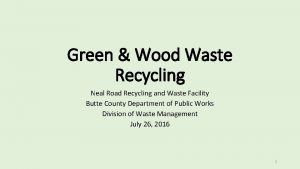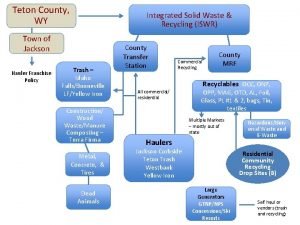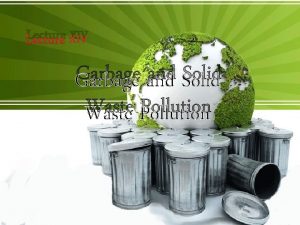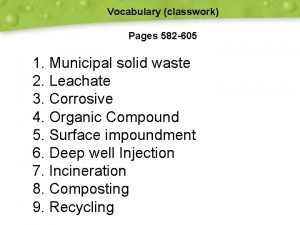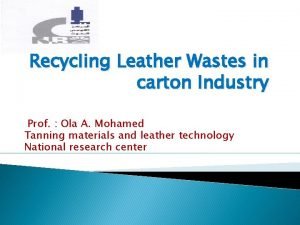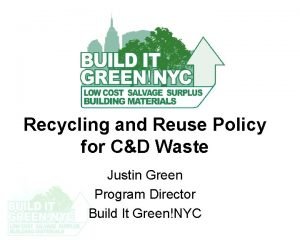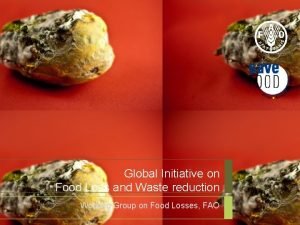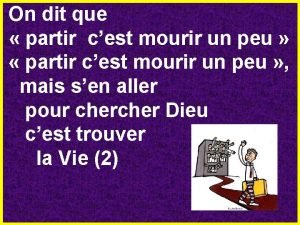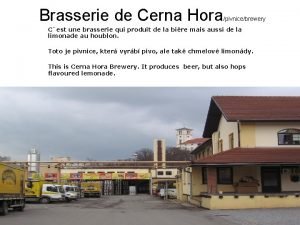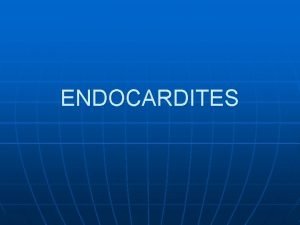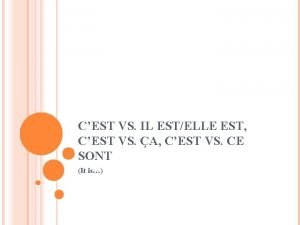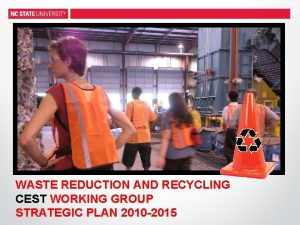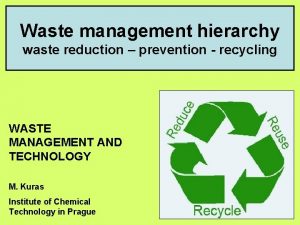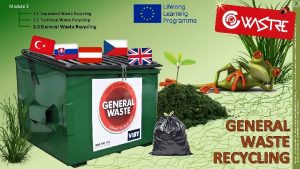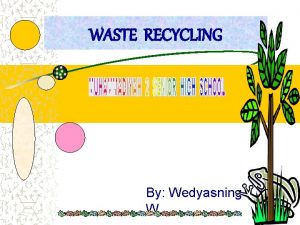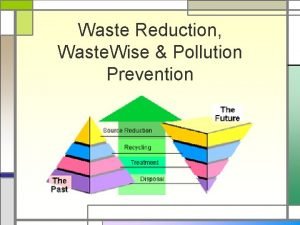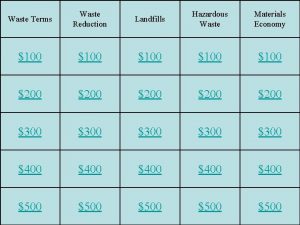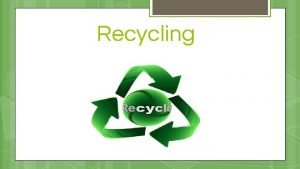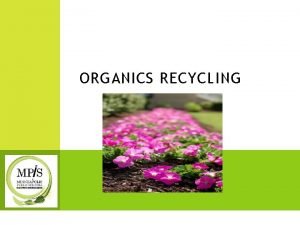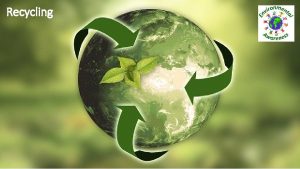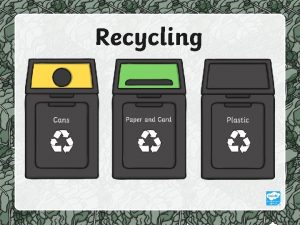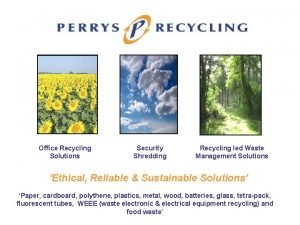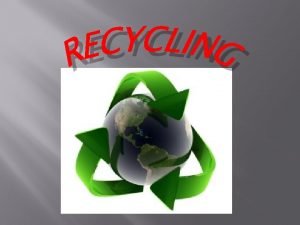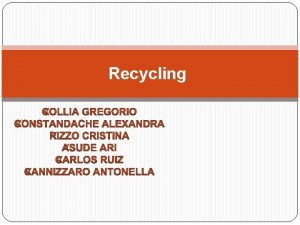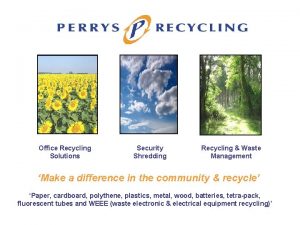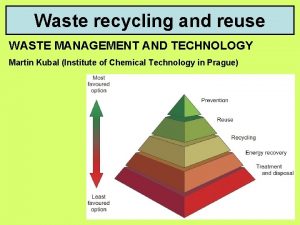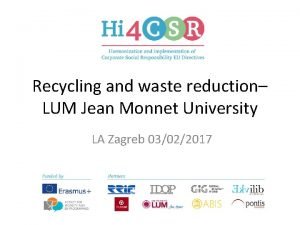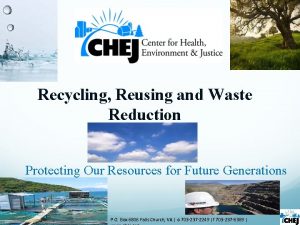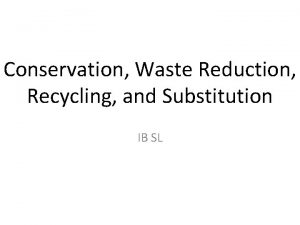WASTE REDUCTION AND RECYCLING CEST WORKING GROUP MEETING























- Slides: 23

WASTE REDUCTION AND RECYCLING CEST WORKING GROUP

MEETING AGENDA • • Introductions CEST mission and organization History of WRR Role of the WRR working group Establish ground rules for the working group Schedule and assignments Next meetings

CEST Mission & Vision (adopted spring 2009) • Who we are The Campus Environmental Sustainability Team (CEST) is a visionary, action-oriented group dedicated to learning about and advancing campus sustainability. • Mission Our mission is to create and implement multifaceted strategies across sustainability components that result in NC State as an environmentally, socially and economically balanced university. • Vision CEST catalyzes campus wide collaboration and shared responsibility to transform NC State into a sustainable community.

Campus Sustainability Program Detailed Flow Chart Chancellor Appoint Co-Sustainability Officers Approve CEST recommendations Executive Officers Review & forward CEST recommendations Co-Sustainability Officers for Operations & Academics/Research Co-chair CEST Present CEST recommendations for endorsement Resources Functional Advisory Campus Environmental Sustainability Team Administrative Advisory Committee Set direction through strategic planning Provide monitoring & accountability for adhering to strategic plan and commitments Chairs of 7 Working Groups: Academics/Research Buildings Energy & Water Land Use Materials & Purchasing Transportation Waste Reduction & Recycling Sustainability Office Student Government Staff Senate Faculty Senate Provost rep Inter-Residence Council Housing rep Centennial rep 2 At large CEST Working Groups Develop & implement strategic & tactical planning Academics/Research Energy Council University Faculty Buildings Capital Projects Management & Design & Construction Services Energy & Water Land Use Office of Energy Management University Architect’s Office Materials & Purchasing Environmental Health and Safety Transportation Purchasing Dept. Transportation Dept. Sustainability Office Waste Reduction & Recycling CEST/Working Group support Accountability/metrics/reporting Communication & outreach Events/Earth Week University Partners Student Orgs. & Student Government Waste Reduction & Recycling Other Campus Offices

CEST Charge • Phase 1: Produce a NC State 5 -year Sustainability Strategic Plan & 1 -year Tactical Plan (SSP+T) by Jan. 2010 • Phase 2: Participate in the creation of NC State’s Climate Action Plan (CAP), beginning Spring 2010 • Phase 3: Expand the Sustainability Tactical Plan to 5 years and revisit Sustainability Strategic Plan once CAP completed • Contribute to Sustainability Annual Report & other scorecards

Sustainability Strategic Plan Climate Action Plan Energy & Water Land Use Buildings Academics & Research Materials & Purchasing Transportation Waste Reduction & Recycling

2010 -2015 Sustain. Strategic Plan Outline I. Exec. Summary - 1 page II. Introduction/Background – 2 pages III. Methodology – 1 -2 pages IV. Strategies – 1 -2 pages per WG/focus V. Communications – 1 -2 pages VI. Strategic Integration – 1 page VII. Conclusion – 1 page VIII. Appendices


Role of the WRR Working Group • 1 st priority- Sustainability Strategic Plan • Where we are now • • • Perspective Foundation Current programs Baseline Existing plans

Video • Fun Theory: http: //www. youtube. com/watch? v=2 l. Xh 2 n 0 a. Pyw &feature=related

Establish Perspective • Think Big! • Solutions vs. Problems • Strategies must be Sustainable – People – Economy – Environment

Brief History of Waste Reduction and Recycling at NC State University 1973 – 1988 - 1980’s- 1990 - 2001 - Physical Plant Reclamation Center and Belt Recycling System built. Belt Recycling System discontinued due to low efficiency for high cost. E. S. King Village pilot program for curbside Residence Hall pilot program launched with central, indoor recycling sites. Yard-Waste composting collection began. Office of Waste Reduction and Recycling was created.

Major Operations • In house Collections Type of Collection Number of Sites Outdoor Sites 218 Indoor Sites 382 Cardboard Dumpsters 107 Trash Dumpsters 178 Autoclave Dumpsters 19 Yardwaste Dumpsters 6 • Solid waste (i. e. all dumpsters on campus) • Paper, cans and bottles (indoor and outdoor) • Bulk debris (C&D, scrap metal, white goods) • Special Collections • Yard Waste

Programs • Education and Outreach • Students, Staff & Faculty, Departments • WE Recycle • America Recycles Day • Pack N Go • Recycle. Mania • Waste Audits

44, 59% NC State Waste Reduction and 40, 48% 39, 13% Recycling Diversion Rate Diversion The percentage of waste materials diverted from traditional disposal such as landfilling or incineration to be recycled, composted, or re-used. Diversion Rate 31, 51% 28, 70% = Recycled/ (Recycled + Waste) 20 07 -2 0 08 07 -2 0 20 06 06 -2 0 20 05 20 04 -2 0 05 04 -2 0 20 03 20 02 -2 0 03 14, 77%

4500 NC State University Waste and Recycling Comparison 4000 3500 3000 2500 Tons Landfill Recycled 2000 1500 1000 500 0 2002 -2003 -2004 -2005 -2006 -2007 -2008

Materials Recycled 2007 -2008 Animal Bedding 11% Paper 27% Yard Waste 33% Commingled 8% C&D 17% Phone books 1% Scrap Metal 3%

Video • http: //www. youtube. com/watch? v=cb. EKAw. Co. C Kw World deepest bin

Current WRR Plans • Social change (Catch phrase) • Source Reduction (collaboration with Purchasing Working Group) • Composting • Household battery recycling • E-Recycling • Walkway Recycling

Homework 1. Basic understanding of mandates and commitments for waste reduction and recycling 2. Overview major existing WRR programs 3. Review other university WRR plans

Resources for Homework • • • www. ncsu. edu/recycling http: //www. p 2 pays. org/ref�3/02221. pdf Landfill Ban presentation http: //www. p 2 pays. org http: //www. aashe. org/resources/waste. php - Create account • http: //www. aashe. org/resources/waste_policies. php Create account

Next Meeting • • SWOT Analysis Vision- diversion rate goal Strategies- how to get there Long Meeting- bring a snack

Meetings • Regular meeting times going forward
 Neal road landfill fees
Neal road landfill fees Rad garbage driggs id
Rad garbage driggs id Wicler
Wicler Recycling of solid waste
Recycling of solid waste Leather waste recycling
Leather waste recycling Cd waste recycling
Cd waste recycling Global initiative on food loss and waste reduction
Global initiative on food loss and waste reduction Hot working and cold working difference
Hot working and cold working difference Cold working disadvantages
Cold working disadvantages Machining operations
Machining operations Pengerjaan panas dan dingin
Pengerjaan panas dan dingin What is meeting and types of meeting
What is meeting and types of meeting What is meeting and types of meeting
What is meeting and types of meeting Smart work and hard work
Smart work and hard work On dit que partir c'est mourir un peu
On dit que partir c'est mourir un peu Cerna hora beer
Cerna hora beer Genitiv singularu česť
Genitiv singularu česť Letat cest moi
Letat cest moi Questce que cest
Questce que cest Michèle torr pas bien dans sa vie
Michèle torr pas bien dans sa vie Letat cest moi
Letat cest moi N'cest pas meaning
N'cest pas meaning Bonjour cest moi
Bonjour cest moi Cest vs est
Cest vs est
